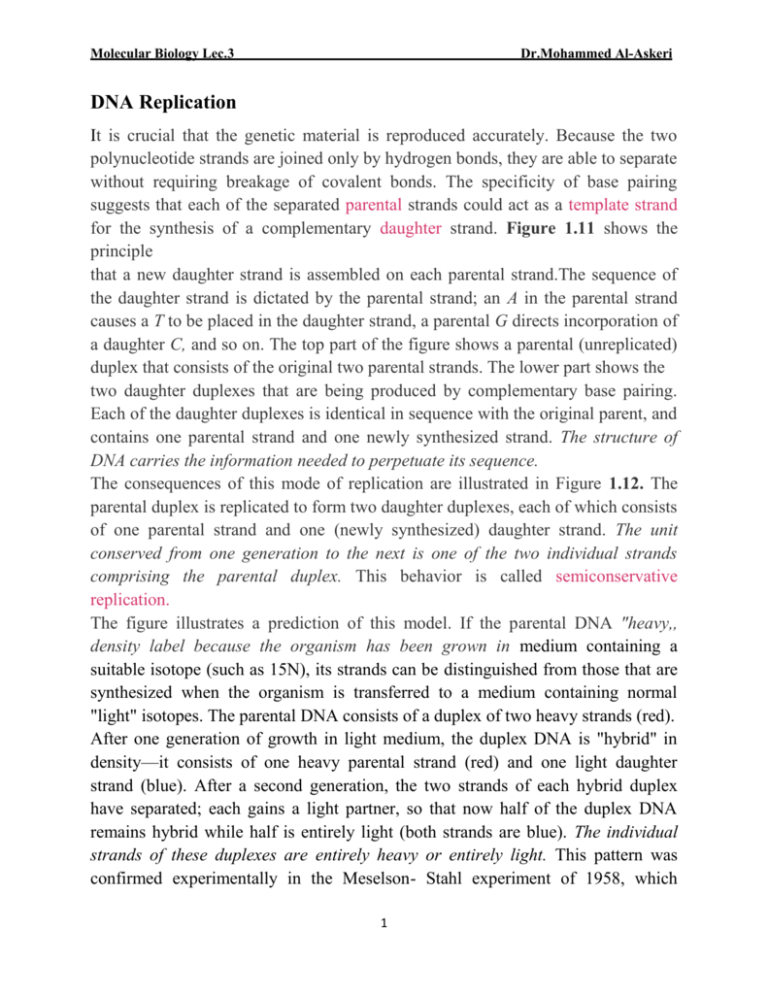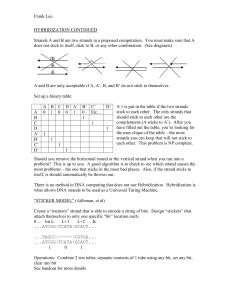DNA Replication
advertisement

Molecular Biology Lec.3 Dr.Mohammed Al-Askeri DNA Replication It is crucial that the genetic material is reproduced accurately. Because the two polynucleotide strands are joined only by hydrogen bonds, they are able to separate without requiring breakage of covalent bonds. The specificity of base pairing suggests that each of the separated parental strands could act as a template strand for the synthesis of a complementary daughter strand. Figure 1.11 shows the principle that a new daughter strand is assembled on each parental strand.The sequence of the daughter strand is dictated by the parental strand; an A in the parental strand causes a T to be placed in the daughter strand, a parental G directs incorporation of a daughter C, and so on. The top part of the figure shows a parental (unreplicated) duplex that consists of the original two parental strands. The lower part shows the two daughter duplexes that are being produced by complementary base pairing. Each of the daughter duplexes is identical in sequence with the original parent, and contains one parental strand and one newly synthesized strand. The structure of DNA carries the information needed to perpetuate its sequence. The consequences of this mode of replication are illustrated in Figure 1.12. The parental duplex is replicated to form two daughter duplexes, each of which consists of one parental strand and one (newly synthesized) daughter strand. The unit conserved from one generation to the next is one of the two individual strands comprising the parental duplex. This behavior is called semiconservative replication. The figure illustrates a prediction of this model. If the parental DNA "heavy,, density label because the organism has been grown in medium containing a suitable isotope (such as 15N), its strands can be distinguished from those that are synthesized when the organism is transferred to a medium containing normal "light" isotopes. The parental DNA consists of a duplex of two heavy strands (red). After one generation of growth in light medium, the duplex DNA is "hybrid" in density—it consists of one heavy parental strand (red) and one light daughter strand (blue). After a second generation, the two strands of each hybrid duplex have separated; each gains a light partner, so that now half of the duplex DNA remains hybrid while half is entirely light (both strands are blue). The individual strands of these duplexes are entirely heavy or entirely light. This pattern was confirmed experimentally in the Meselson- Stahl experiment of 1958, which 1 Molecular Biology Lec.3 Dr.Mohammed Al-Askeri followed the semiconservative replication of DNA through three generations of growth of E. coll.When DNA was. extracted from bacteria and its density measured by centrifugation, the DNA formed bands corresponding to its densit heavy for parental, hybrid for the first generation, and half hybrid and half light in the second generation. 2 Molecular Biology Lec.3 Dr.Mohammed Al-Askeri 3








